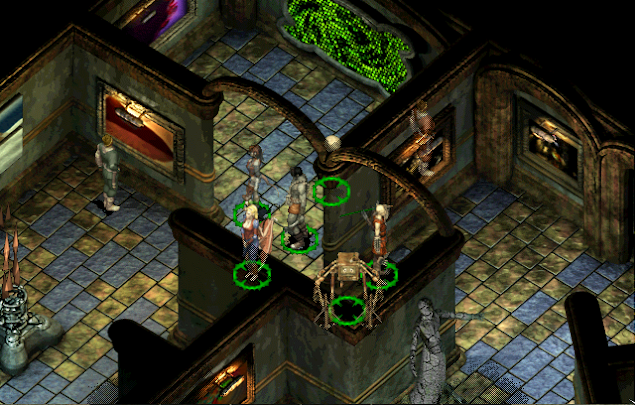I just went through the game’s “Art
Store,” area, the last place I have to go before going through the
Sensorium and advancing to the next stage of the game. It’s a bit
of an odd name, since you can’t actually buy any art there; rather,
it’s an area where you can pick up a few items, activate a missing
memory, and propel the odd side quest. It’s also a subarea that
fits the tone of the larger area it’s found in. You begin the game
in Sigil’s slums, and you run into a lot of beggars and so forth.
Later, you go to the Lower Wards, where there’s a large enclosed
market, and a factory. And the Art Store is the Clerk’s Ward, where
the upper class aristocrats hang up. So that’s a nice, simple
thematic consistency.
 |
| Behold, the wondrous miracle of art! My party of cat ladies, robots, and floating skulls are appropriately amazed at the strangeness. |
But despite being a stopping point for
the odd quest or two, the Art Shop mostly exists on its own. In all,
there’s sixteen artifacts to interact with, and seventeen if you
count the shop’s owner, Yves. Like most NPCs in the game, you can
query her for information about the general area—but unlike most,
her answers are all the same: she doesn’t really know anything
about the rest of Sigil. She does, on the other hand, know a lot
about the Planescape multiverse at large—or at least, anything
relevant to her collection. And that of course reinforces the notion
that the place exists somewhat separately from the rest of Clerk’s
Ward. She’s also blind, which is a somewhat obvious attempt at
reversing expectations: the art collector can’t see her art. But
the catch is that she’s deliberately willing herself blind. She
wants to forget what the art around her looks like, so she can see it
from a fresh perspective. It’s not the first time this idea is
presented in the game, either, as one of the quests that can be
solved by venturing here is finding ice from the River Styx that
grants its consumer oblivion, which you dutifully give to a wizard
named Merriman who feels he needs to start over to find new
experiences. (After you get the mug of frost from another wizard by getting him to forget his desire to drink so that you can carry the ice,
that is—and after you give it over, Merriman gives you the keys to
unlock the woman who gives you the information on another woman that
lets you use the fiend’s tongue and the deva’s tear to restore that second woman's voice and hear her
information. It’s a long side quest.)
One of the major groups of the area is
the Sensates; I’ll get into them more at another time, but their
basic ideology is that knowledge of the world is gained through
sensory experience. Merriman and Yves both suggest that it’s
possible to know too much, and to experience too much, that
forgetting is not only necessary but to be desired. And that has
further ramifications. Remember (heh), your PC is the Nameless One, a
man who has forgotten his own past. The entire game is predicated on
the PC slowly questing to regain those memories. But by the time you’ve
reached the Art Shop, the game’s revealed that who you were was a
rather terrible person (or many terrible people, depending on your
view), and perhaps a lack of experience, a lack of knowledge, is to
be preferred.
Next time: we get around to talking about the other 16
interactive artifacts.
Later Days.
No comments:
Post a Comment